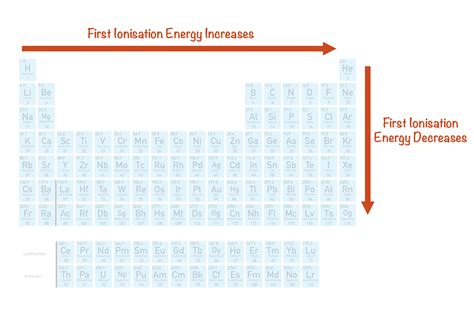In the realm of chemistry, the first ionization energy is a fundamental property that dictates the reactivity and behavior of elements. It represents the minimum energy required to remove an electron from an atom, influencing a wide array of chemical processes and applications. Among all elements, the lowest first ionization energy belongs to cesium, a highly reactive metal, opening up a world of possibilities in various domains.

Understanding First Ionization Energy
When an atom loses an electron, it becomes positively charged, a process known as ionization. The first ionization energy, denoted as IE1, measures the difficulty of removing the outermost electron from an atom. It is expressed in units of kilojoules per mole (kJ/mol) or electronvolts (eV).
The Lowest First Ionization Energy: Cesium
With a first ionization energy of a mere 375.7 kJ/mol (3.89 eV), cesium stands alone as the element with the lowest IE1. This exceptionally low energy requirement makes cesium highly reactive, readily donating its outermost electron to form positive ions.
Applications of Cesium’s Low Ionization Energy
The low first ionization energy of cesium has paved the way for its use in diverse applications. Its unique properties find value in:
- Atomic Clocks: Cesium is the heart of atomic clocks, which maintain exceptionally precise timekeeping due to the precise energy difference between two electron states in cesium atoms.
- High-Intensity Ion Beams: Cesium’s low IE1 enables it to generate high-intensity ion beams used in particle accelerators and ion thrusters for spacecraft propulsion.
- Vapor Lamps: Cesium vapor lamps produce intense blue light, employed in traffic signals, beacons, and automotive headlamps.
- Ionization Detectors: Cesium-based ionization detectors are vital for detecting and measuring ionizing radiation.
Factors Influencing First Ionization Energy
Several factors influence the first ionization energy of an element:
- Atomic Radius: Larger atoms have more loosely bound electrons, resulting in lower IE1.
- Nuclear Charge: The number of protons in the nucleus exerts a stronger attraction on electrons, raising IE1.
- Electron Configuration: Elements with half-filled or completely filled orbitals (noble gases) have higher IE1.
- Ionization Potential: The ionization potential, closely related to IE1, is the minimum energy needed to remove an electron and directly affects an element’s reactivity.
Table of First Ionization Energies
The following table presents the first ionization energies of various elements:
| Element | First Ionization Energy (kJ/mol) |
|---|---|
| Cesium | 375.7 |
| Rubidium | 403.0 |
| Potassium | 418.8 |
| Lithium | 520.2 |
| Sodium | 495.8 |
| Magnesium | 737.7 |
| Calcium | 589.8 |
| Zinc | 906.4 |
Applications of Low First Ionization Energy in Emerging Fields
The search for elements with low first ionization energies continues to drive innovation in emerging areas:
- Green Energy: Cesium-coated electrodes enhance the efficiency of solar cells by reducing recombination losses.
- Quantum Computing: Cesium atoms are promising candidates for quantum bits (qubits) due to their well-defined energy levels.
- Biomedical Applications: Cesium isotopes are used as tracers and imaging agents in medical diagnostics.
- Industrial Processes: Cesium’s ionization properties contribute to the development of improved lighting, lasers, and medical devices.
Conclusion
The lowest first ionization energy belongs to cesium, a highly reactive metal with versatile applications across various domains. Understanding the factors influencing IE1 enables researchers and scientists to optimize chemical reactions, design innovative technologies, and push the boundaries of scientific discovery. As the pursuit of low-ionization-energy elements continues, new applications will undoubtedly emerge, shaping the future of science and technology.
